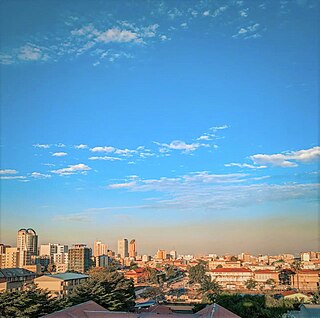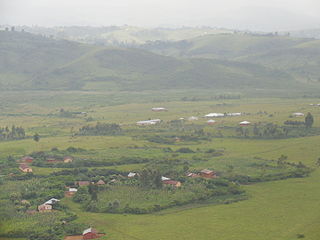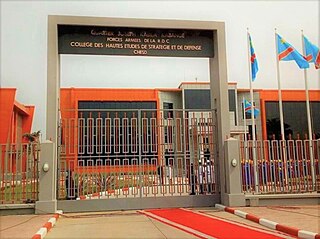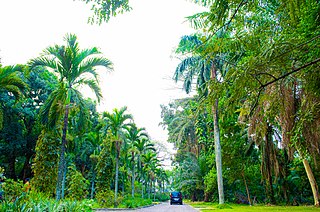
Kinshasa, formerly named Léopoldville before June 30, 1966, is the capital and largest city of the Democratic Republic of the Congo. Once a site of fishing and trading villages along the Congo River, Kinshasa is now one of the world's fastest-growing megacities. With an estimated population of 16 million residents, it's the most densely populated city in the DRC and the most populous city in Africa. It is Africa's third-largest metropolitan area and the leading economic, political, and cultural center of the DRC. Kinshasa houses several industries, including manufacturing, telecommunications, banking, and entertainment. The city also hosts some of DRC's significant institutional buildings, such as the Palais du Peuple, Palais de la Nation, Court of Cassation, Constitutional Court, Cité de l'Union Africaine, Palais de Marbre, Stade des Martyrs, Immeuble du Gouvernement, Kinshasa Financial Center, and multiple federal departments and agencies.

Étienne Tshisekedi wa Mulumba was a Congolese politician and the leader of the Union for Democracy and Social Progress (UDPS), the main opposing political party in the Democratic Republic of the Congo (DRC). A long-time opposition leader, he served as Prime Minister of the country on three brief occasions: in 1991, 1992–1993, and 1997. He was also the father of the current President, Felix Tshisekedi.

The Stade des Martyrs de la Pentecôte, or simply the Stade des Martyrs, is the national stadium of the Democratic Republic of the Congo (DRC), located in the Kinshasa commune of the capital Kinshasa. With a seating capacity of 80,000, it is the largest stadium in the DRC and the fourth-largest stadium in Africa. It serves as the home stadium for the Congolese football national team, AS Vita Club, and DCMP, making it the largest multifunctional venue in the country.

Gombe, also known as La Gombe, or Downtown Kinshasa, is one of the 24 communes of Kinshasa, in the western part of the Democratic Republic of the Congo (DRC). Encompassing a vast area of approximately 29.33 square kilometers, it is home to an approximate population of 49,024 residents (2014).

The Boulevard du 30 Juin is a major 5‑km street in Kinshasa, Democratic Republic of the Congo (DRC). It is the city center's main transport artery, connecting the southern area of La Gombe with Kintambo and the Ngaliema to the west.

The Régie de Distribution d'Eau, abbreviated as REGIDESO, is a state-owned utility company located on Boulevard Du 30 Juin, in the Gombe commune of Kinshasa, Democratic Republic of the Congo (DRC). It is responsible for producing and distributing water throughout the national territory, encompassing both urban and rural areas. Established in 1929, REGIDESO operates autonomously within the Department of Mines and Energy under the government of the DRC.

Minembwe is a cluster of several villages located in the highlands of the Lulenge, within the Fizi Territory of South Kivu Province in the Democratic Republic of the Congo (DRC). It is situated at an altitude of about 2,500 meters above sea level, in a hilly and mountainous region covered with forests, which provides fertile land for agriculture. It is approximately 150 kilometers south of Bukavu, the capital city of South Kivu. The region is also home to various streams and rivers that flow into Lake Tanganyika, the second-deepest lake in the world.

The Palais de la Nation is the official residence and principal workplace of the President of the Democratic Republic of the Congo. It is strategically situated in Gombe, north of Kinshasa, adjacent to the course of the Congo River, and has held its role since 2001, following the assassination of Laurent-Désiré Kabila.
Baudouin Banza Mukalay Nsungu was a Congolese politician, born in Coquilhatville. He had most recently served as the Minister of Culture and the Arts of the Democratic Republic of Congo from December 2014 until his death in May 2016. Previously, Mukalay served as Minister of Youth, Sports, Culture and the Arts from April 2012 until December 2014 under President Joseph Kabila and Minister of Mines from 1996 to 1997 under Zaire President Mobutu Sese Seko.

Samy Badibanga Ntita is a Congolese politician who was Prime Minister of the Democratic Republic of the Congo from November 2016 to May 2017. He was also on the ballot for the 2018 Democratic Republic of the Congo general election as a presidential candidate.

General elections were held in the Democratic Republic of the Congo on 20 December 2023. Combined elections were held for the President, 484 of the 500 members of the National Assembly, 700 of the 716 elected members of the 26 provincial assemblies, and for the first time under the new constitution, 951 members of a scaled down number of commune (municipal) councils. On election day, the Congolese government extended voting to 21 December for polling stations that had not opened on 20 December. Agence France-Presse reported that some polling stations would open as late as 24 December.
Tharcisse Kasongo Mwema Yamba-Yamba was a Congolese journalist and politician.
The Sacred Union of the Nation is the ruling parliamentary coalition within the parliament of the Democratic Republic of the Congo. It comprises several parties including the Union for Democracy and Social Progress, the Union for the Congolese Nation, the Movement for the Liberation of the Congo, the Unified Lumumbist Party, and the Alliance of the Democratic Forces of Congo and Allies. It was formed in December 2020 by Felix Tshisekedi following a falling out between the Heading for Change coalition and Joseph Kabila's Common Front for Congo. In April 2021 the coalition was able to take control of the government after a four-month-long power struggle. As of June 2023, the coalition is made up of 391 members coming from 24 different political parties.
The Kinshasa Central Market, colloquially referred to as Zando in Lingala, is a marketplace located within the Gombe commune of Kinshasa, in the Democratic Republic of the Congo (DRC). Covering an expansive 90,000 square meters, it was Kinshasa's largest marketplace during Mobutu Sese Seko's reign. It was eventually eclipsed by the Marché de la Liberté during the late President Laurent-Désiré Kabila's tenure. As of May 1989, the market accommodated 15,500 vendors. By 2020, that number had risen to 35,000 vendors. Renowned for its wide assortment of products, including fruits, vegetables, meat, fish, spices, cooked meals such as chikwangue, clothing, fabrics, shoes, accessories, and household goods, the marketplace also showcases distinctive Congolese handicrafts and souvenirs for tourists and visitors.

The Collège des Hautes Études de Stratégie et de Défense, acronymed as CHESD, also known as the College of Advanced Studies in Strategy and Defense, is the highest institution for military education focused on national security under the Ministry of Defense and Veterans Affairs of the Democratic Republic of Congo. Situated within the former base of the operational reserves of the Force Publique on the Avenue du Haut Commandement in Kinshasa's Gombe commune, it provides training for general and senior officers, along with colonels of the FARDC. Incidentally, the institution offers postgraduate programs tailored for senior executives, both civilian and military, coming from domestic and international backgrounds.

The Gare de l'Est, also known as Kinshasa Est or Kinshasa Central Station, is a central railway station situated in the Gombe commune of Kinshasa, Democratic Republic of the Congo (DRC). Positioned along the Matadi–Kinshasa Railway line, it functions as a pivotal transshipment point connecting the railway and the river. Managed by the Société Commerciale des Transports et des Ports, the station stands near Ngobila Beach at the Port of Kinshasa, fostering maritime links with Brazzaville, and is conveniently located close to SCTP buildings and the Ministry of Transport and Channels of Communication.
The Université Pédagogique Nationale, formerly named the Institut Pédagogique National, colloquially referred to by its acronym UPN, is a public institution of higher education dedicated to training teachers, enhancing their skills, and promoting studies and research in applied pedagogy. Located in the Ngaliema commune of Kinshasa, Democratic Republic of the Congo (DRC), the university is led by Professor Masanga Maponda Anastasie. Established in 1961, it is the first pedagogical university in the Democratic Republic of the Congo.

The Cité de l'Union Africaine or Cité de l'OUA is a governmental complex situated in the Ngaliema commune of Kinshasa, Democratic Republic of the Congo (DRC). It is strategically located near Mont Ngaliema and serves as a venue for diplomatic and governmental functions.

The Kinshasa Botanical Garden, formerly known as the Fernand De Boeck Park, is a botanical garden located in Gombe, Kinshasa, in the western part of the Democratic Republic of the Congo (DRC). Covering seven hectares, It is strategically positioned opposite the Kinshasa Zoological Garden on Kasa-Vubu Avenue. The botanical garden houses a diverse collection of 286 plant species, including nurseries, a seed collection, an arboretum of native species, and a herbarium. Established in 1933, It is managed by the Congolese Institute for the Conservation of Nature and serves as a hub for environmental education activities, boasting over 100 arboreal species.
The Kinshasa Financial Center is a financial hub strategically located in the Gombe commune of Kinshasa, in the western region of the Democratic Republic of the Congo (DRC). Covering a total area of 41,000 square meters, it is the largest financial center in the DRC. The center houses key institutions such as the Ministries of Finance and Budget, the General Directorates, the General Inspectorate of Finance, the General Secretariat of Finance, and the Development Bank. It is administered by the state-owned Investment Fund commercial entity, which supervises real estate assets like the financial and convention centers.































